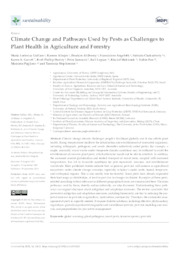Climate change and pathways used by pests as challenges to plant health in agriculture and forestry.
Climate change and pathways used by pests as challenges to plant health in agriculture and forestry.
Author(s): GULLINO, M. L.; ABAJES, R.; AL-JBOORY, I.; ANGELOTTI, F.; CHAKRABORTY, S.; GARRETT, K. A.; HURLEY, B. P.; JUROSZEK, P.; LOPIAN, R.; MAKKOUK, K.; PAN, X.; PUGLIESE, M.; STEPHENSON, T.
Summary: Climate change already challenges people?s livelihood globally and it also affects plant health. Rising temperatures facilitate the introduction and establishment of unwanted organisms, including arthropods, pathogens, and weeds (hereafter collectively called pests). For example, a single, unusually warm winter under temperate climatic conditions may be sufficient to assist the establishment of invasive plant pests, which otherwise would not be able to establish. In addition, the increased market globalization and related transport of recent years, coupled with increased temperatures, has led to favorable conditions for pest movement, invasion, and establishment worldwide. Most published studies indicate that, in general, pest risk will increase in agricultural ecosystems under climate-change scenarios, especially in today?s cooler arctic, boreal, temperate, and subtropical regions. This is also mostly true for forestry. Some pests have already expanded their host range or distribution, at least in part due to changes in climate. Examples of these pests, selected according to their relevance in different geographical areas, are summarized here. The main pathways used by them, directly and/or indirectly, are also discussed. Understanding these path-ways can support decisions about mitigation and adaptation measures. The review concludes that preventive mitigation and adaptation measures, including biosecurity, are key to reducing the projected increases in pest risk in agriculture, horticulture, and forestry. Therefore, the sustainable management of pests is urgently needed. It requires holistic solutions, including effective phytosanitary regulations, globally coordinated diagnostic and surveillance systems, pest risk modeling and analysis, and preparedness for pro-active management.
Publication year: 2022
Types of publication: Journal article
Unit: Embrapa Semi-arid Region
Observation
Some of Embrapa's publications are published as ePub files. To read them, use or download one of the following free software options to your computer or mobile device. Android: Google Play Books; IOS: iBooks; Windows and Linux: Calibre.
Access other publications
Access the Agricultural Research Database (BDPA) to consult Embrapa's full library collection and records.
Visit Embrapa Bookstore to purchase books and other publications sold by Embrapa.

